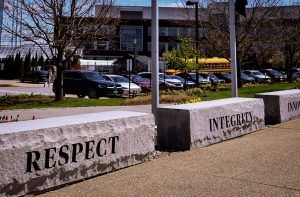‘Areas and styles and perspective:’ Balancing dance and technology
May 4, 2021
Dim lights highlighted projected videos and moving images illuminating the walls behind dance students as they performed their second in-class media and choreography study.
In the Contemporary IV dance class, students learn how to find a facilitating balance between dance and technology.
Dancers were required to film three 30 second videos of themselves: one standing stationary while the background was moving, one dancing, and one from an unusual perspective.
“Technology is part of the dance. As soon as you use music you are using technology. As soon as you are dancing under the lights of a stage, you are using technology,” Paula Higa, the instructor of the class, said.
The students edited the videos together and were then tasked with creating a dance to complement the videos that would be projected on the wall behind them for their performance.
Higa said the goal of this project was to explore how videos can transport the dancer into an environment other than the room they are in. Students created their projects using the programming system Isadora.
“Isadora is an interactive media, it’s not just a projection behind the dancer. The dancer/choreographer has the opportunity to interact with the projection,” Higa said.
Isadora has features you can use to create live caption motion, edit videos and create collages of photos which can then be projected onto the wall or floor to use in your dance.
According to Higa, “pure dancing” is movement in nature with live music or the sounds of that surrounding nature. She said costumes can even be considered as technology.
Junior Josh Huffman explored the concept of “stepping out of yourself and into yourself” through his project. For his live performance, Huffman dressed in the same clothes he wore in his video projection and experimented with the size of the image so it appeared as if he was dancing with a duplicate version of himself.
Huffman said that he embraced the opportunity to incorporate technology into the performing arts.
“I don’t think technology should be necessarily shunned away. Dance has its different areas and styles and perspective, but at the end of the day we as society are advancing and if dance wants to stay relevant to the audience, it’s going to have to reflect what the audience is used to,” Huffman said.
Huffan said that it’s important to incorporate current technology that the audience can relate to, but that technology should be digestible and not overcomplicate the dance, potentially leaving the audience confused.
Junior Emma DiBacco said that technology can strengthen a performance.
“It’s important that there’s a balance so that the technology doesn’t over power the dance. Technology can be used to enhance a dance, but you don’t want it to take away from the dance,” DiBacco said.
DiBacco edited her videos with purple tints and other funky transitions to emit a spooky vibe for her projection and performed choreography that directly responded to the changing images.
“The project was so cool because I edited three generic videos into my style,” DiBacco said.
Dibacco said that the project gave her the opportunity to reflect on creativity in different ways.
Over the course of the semester, students have learned how to incorporate advanced technology into their dances and have further discovered how to create a relationship between the two art forms.






